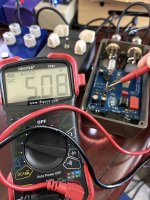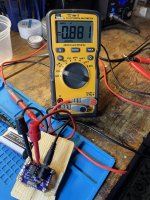MichaelW
Well-known member
So this is the third of the boards from @fig. I was totally not expecting it, but I love boosts! I cannot lie....@fig must know this
Anyway, another board courtesy to the Pedal Triumvirate @Chuck D. Bones design, @cooder @ Bignoise Amplification layout and @fig Logistics and Supply Chain!
Super easy build at first glance but if you read Chucks Breadboard post here....you can see that the details of the specs of both the GE NPN and JFET specs needed to the correct voltages for best performance. I wound up using a random 2N5458 as a starting point just to get the pedal built and tested. (more on that in a bit)
The Ge is a GT404B and one of the only 2 NPN's I had in the correct HFE range, So it's staying in, tomorrows project is figure out how to calculate Vp and sort JFETs hahaha. Having said that even with the not quite right FET in there pedal sounds great!
(Ge Collector voltage was 5.98v so it's right in there according to the schematic)
Not really a super clean boost but more like dirtier and dirtier, it actually functions as it's own overdrive.
There's a 3 way toggle, Middle is clean-ish but you can crank the gain for an overdrive sound, top position is 10db volume boost, down toggle position brings in the Ge and turns it into a Treble Booster, very cool! The only pedals I've tried pushing with it last night is the Cattle Driver and CowPoker so far. With the Cattle Driver it sounds amazing! With the Cowpoker it's sick over the top...hahah. But all on its own it can provide some nice crunch even in the middle toggle setting.
For those you sitting on this board, highly reccomend you build it!
The only sub I made was for the 3u3 film cap, the schematic (attached below) shows 1uf in @Chuck D. Bones original circuit so I went with that.
Like in my "lessons learned" from the 'Lectric Mama Flanger and CowPoker boards, there are a few additional components on this board that are not in the schematic.
It's such a low parts count that I did not bother creating a BOM list but pulled parts from the schematic.
Missing from the schematic (if you're building this)
All related to the relay switching circuit:
1k r
10k r
4k7 r
78L05
100p caps x 3
Relay Pic (sent by @fig)
Relay (sent by @fig)
This is another killer @Chuck D. Bones design. Going to play around with testing some JFets to find one with the correct Vp today.
I was chatting with Chuck offline last night and he confirmed my random 2N5458 is "no bueno" for this circuit.
I'm only getting 2.6v at the Drain leg of the FET. It should be ~ 5v with the correct Vp in the FET.
It sounds so dang good with it the way it is, I'm eager to see what it sounds like with the correct value FET in there!!
Thank you again @Chuck D. Bones, @cooder and @fig!!!
This is my last Tayda Glimmer Brown Sugar enclosure. Trying to hold off ordering any more enclosures until I used up what I have left.
I had to do an "angled leg bend" on the pots in order to get the holes in the right place to use those cool knobs that have been looking for a project.
They're really tall and I thought they might overpower the size of a 125B but I think they turned out ok.
I used a set of the Tayda open frame jacks. These are .87 ea today!! Ridiculously good jack for that kind of price.
Quality I would say falls somewhere near the GLS and Neutrik Rean jacks I had been using but these cost less.
They are slightly shorter in overall length of the "tip leg" so it also saves a little space for tight builds.
One last benefit is that the solder lugs don't reject solder like the GLS jacks do. These are my new goto jacks for sure! Thank you @cdwillis and @Coda for the tip.
Digging these! @Roberman @Route14 you should definitely throw a couple of these on your next Tayda order.
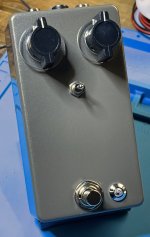
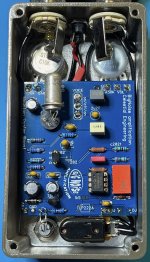
Edit: forgot to attach the schematic....here it is.....mind the voltages on the FET and Ge. Those are the targets you want.
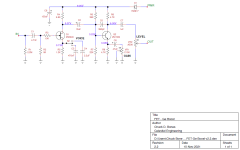
Anyway, another board courtesy to the Pedal Triumvirate @Chuck D. Bones design, @cooder @ Bignoise Amplification layout and @fig Logistics and Supply Chain!
Super easy build at first glance but if you read Chucks Breadboard post here....you can see that the details of the specs of both the GE NPN and JFET specs needed to the correct voltages for best performance. I wound up using a random 2N5458 as a starting point just to get the pedal built and tested. (more on that in a bit)
The Ge is a GT404B and one of the only 2 NPN's I had in the correct HFE range, So it's staying in, tomorrows project is figure out how to calculate Vp and sort JFETs hahaha. Having said that even with the not quite right FET in there pedal sounds great!
(Ge Collector voltage was 5.98v so it's right in there according to the schematic)
Not really a super clean boost but more like dirtier and dirtier, it actually functions as it's own overdrive.
There's a 3 way toggle, Middle is clean-ish but you can crank the gain for an overdrive sound, top position is 10db volume boost, down toggle position brings in the Ge and turns it into a Treble Booster, very cool! The only pedals I've tried pushing with it last night is the Cattle Driver and CowPoker so far. With the Cattle Driver it sounds amazing! With the Cowpoker it's sick over the top...hahah. But all on its own it can provide some nice crunch even in the middle toggle setting.
For those you sitting on this board, highly reccomend you build it!
The only sub I made was for the 3u3 film cap, the schematic (attached below) shows 1uf in @Chuck D. Bones original circuit so I went with that.
Like in my "lessons learned" from the 'Lectric Mama Flanger and CowPoker boards, there are a few additional components on this board that are not in the schematic.
It's such a low parts count that I did not bother creating a BOM list but pulled parts from the schematic.
Missing from the schematic (if you're building this)
All related to the relay switching circuit:
1k r
10k r
4k7 r
78L05
100p caps x 3
Relay Pic (sent by @fig)
Relay (sent by @fig)
This is another killer @Chuck D. Bones design. Going to play around with testing some JFets to find one with the correct Vp today.
I was chatting with Chuck offline last night and he confirmed my random 2N5458 is "no bueno" for this circuit.
I'm only getting 2.6v at the Drain leg of the FET. It should be ~ 5v with the correct Vp in the FET.
It sounds so dang good with it the way it is, I'm eager to see what it sounds like with the correct value FET in there!!
Thank you again @Chuck D. Bones, @cooder and @fig!!!
This is my last Tayda Glimmer Brown Sugar enclosure. Trying to hold off ordering any more enclosures until I used up what I have left.
I had to do an "angled leg bend" on the pots in order to get the holes in the right place to use those cool knobs that have been looking for a project.
They're really tall and I thought they might overpower the size of a 125B but I think they turned out ok.
I used a set of the Tayda open frame jacks. These are .87 ea today!! Ridiculously good jack for that kind of price.
Quality I would say falls somewhere near the GLS and Neutrik Rean jacks I had been using but these cost less.
They are slightly shorter in overall length of the "tip leg" so it also saves a little space for tight builds.
One last benefit is that the solder lugs don't reject solder like the GLS jacks do. These are my new goto jacks for sure! Thank you @cdwillis and @Coda for the tip.
Digging these! @Roberman @Route14 you should definitely throw a couple of these on your next Tayda order.


Edit: forgot to attach the schematic....here it is.....mind the voltages on the FET and Ge. Those are the targets you want.

Last edited:


